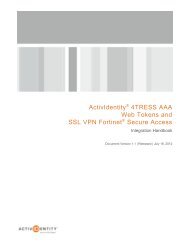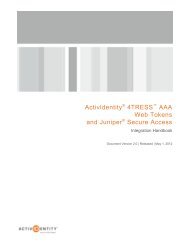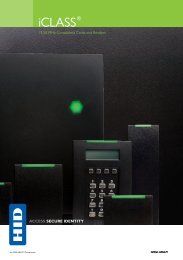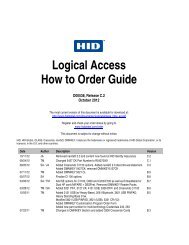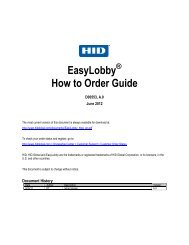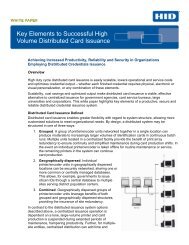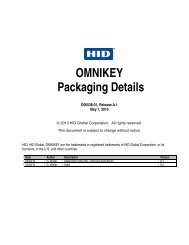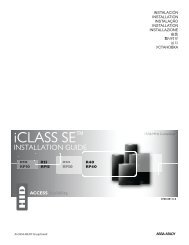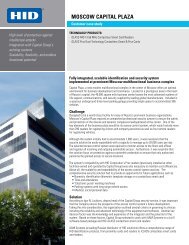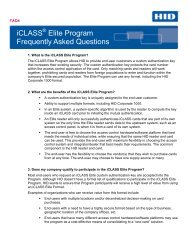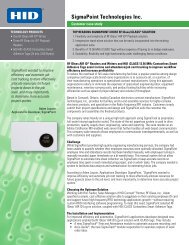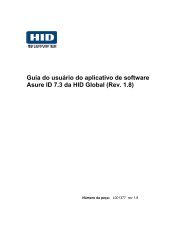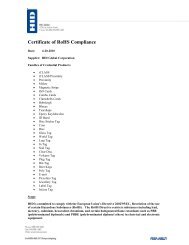pivCLASS Solutions Brochure - HID Global
pivCLASS Solutions Brochure - HID Global
pivCLASS Solutions Brochure - HID Global
You also want an ePaper? Increase the reach of your titles
YUMPU automatically turns print PDFs into web optimized ePapers that Google loves.
Figure 1<br />
<strong>pivCLASS</strong> Readers Meet Any<br />
Authentication Mode and Any<br />
Assurance Level<br />
“Controlled” Areas<br />
“Limited” Areas<br />
“Exclusion” Areas<br />
<strong>pivCLASS</strong> ® Readers<br />
The <strong>pivCLASS</strong> Government Solution suite<br />
includes a broad selection of readers for<br />
agencies to meet any security level and the<br />
NIST SP 800-116 guidelines. <strong>pivCLASS</strong> readers<br />
work with the <strong>pivCLASS</strong> Authentication<br />
Module to meet requirements for:<br />
Any assurance level: controlled, limited or<br />
exclusion.<br />
Any authentication mode: CHUID,<br />
CAK, PIV + PIN, or PIV + PIN + BIO;<br />
also, FASC-N reads for non-SP800-116<br />
“uncontrolled” areas, and the additional<br />
TWIC authentication modes, CHUID + BIO<br />
and CAK + BIO.<br />
Meet Any Assurance Level<br />
Security Area<br />
(per NIST SP800-116<br />
& Risk Assessment)<br />
Authentication<br />
Factors<br />
Nearly any card type, contact or<br />
contactless, including PIV, PIV-I, CIV (a.k.a.,<br />
PIV-C), TWIC, FRAC and CAC.<br />
Additionally, <strong>pivCLASS</strong> readers provide fully<br />
functional backward compatibility with existing<br />
Authentication<br />
Modes<br />
Revoked<br />
iCLASS ® and <strong>HID</strong> Prox readers, easing the<br />
transition from legacy cards to PKI-based<br />
credentials. The readers also support bi-<br />
directional communication to the PAM.<br />
Assurance Levels and Authentication Modes<br />
Most Federal facilities have likely completed a<br />
risk assessment that designated each door and<br />
portal as requiring an uncontrolled, controlled,<br />
limited or exclusion assurance level. NIST SP<br />
800-116 specifies which authentication modes<br />
are required for which assurance levels. For<br />
instance, a door leading to a high security area<br />
will require a more advanced reader (in order<br />
to perform additional identity checks, such<br />
as biometric fingerprint match) than a lower<br />
security door.<br />
Figure 1 illustrates the different security levels<br />
and the attack vectors addressed by the<br />
<strong>pivCLASS</strong> solution.<br />
Secures against cards that are...<br />
Counterfeit<br />
or Altered<br />
Copied<br />
or Cloned<br />
Lost<br />
or Stolen<br />
Uncontrolled None FASC-N �<br />
Controlled 1 CHUID + VIS � �<br />
Controlled 1 CAK � � �<br />
Limited 2 PIV + PIN � � � �<br />
Exclusion 3 PIV + PIN + BIO � � � � �<br />
BIO: Biometric; CAK: Card Authentication Key; CHUID: Cardholder Unique Identifier; FASC-N: Federal Agency Smart Credential Number; PIN: Personal Identification Number; PIV: Personal Identity Verification (PIV) Authentication Key; VIS: Visual<br />
Shared



